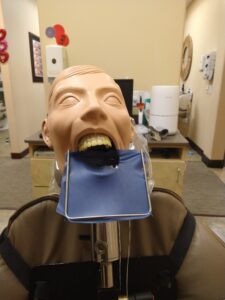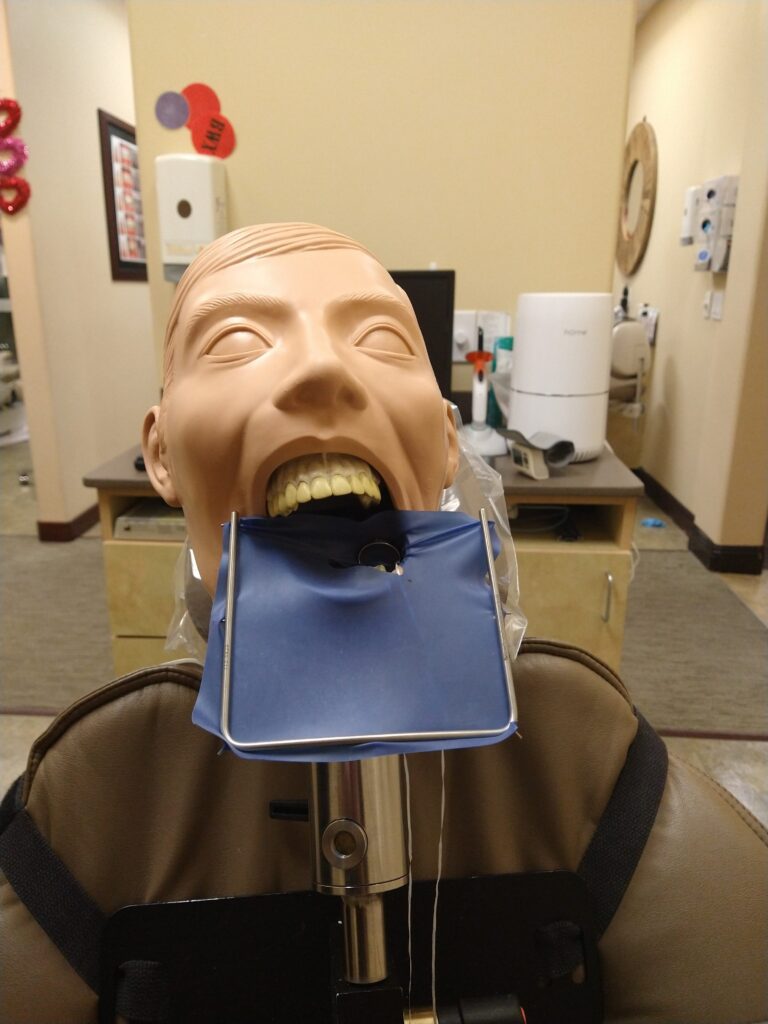Setting a Rubber Dental Dam
At Santa Clarita School of Dental Assisting, we train the best students. Not only that, but we get our students ready to enter the real-world work force in ONLY 12 WEEKS! On of the things we teach our students is how to place a rubber dental dam.
What Are Rubber Dental Dams?
Dental dams are six-inch sheets of latex or nitrile used in dentistry to isolate the tooth or teeth that is being worked on. Furthermore, the rubber dental dams are used to prevent saliva from interfering with the dental work. Also, they prevent instruments and materials from being inhaled, swallowed or damaging the mouth.
Armamentarium:
- Rubber dam sheets
- Clamps and hooks
- Frame
- Forceps
- Dam Punch
- Dental Floss
- Oral seal (may be used)
- Wooden Wedged (may be used)
- Wedjest (may be used)
Our Students Learning How to Set Rubber Dental Dams
It takes time and practice to get good at setting dental dams. Thanks to our amazing instructors and hands on training, our students get plenty of quality practice. Below, is a video of one of our sessions on dental dams.
Advantages of Rubber Dental Dams
To begin, as we briefly discussed above, it provides a clean and dry operating environment free of blood and saliva. This is great for the bonding of adhesives and cements as they benefit from clean and dry areas. On the other hand, if the environment is contaminated and leads to poor boning of materials, the success of the longevity of the restoration will be shortened.
Additionally, the use of rubber dental dams assists with visibility. The sheets create a great contrast against the teeth, they also hide the tongue, cheeks, and reduces fogging of mirrors.
While some argue that it takes too much time to apply the sheets and it makes communication with the patient difficult, it’s actually great for those patients who talk too much and interfere with your work.
Below is a video of doctor showing his technique.
What Was Used Before Rubber Dental Dams?
Nothing. Before rubber dental dams, there really wasn’t anything to use. In fact, many dental procedures had a high risk of contamination from saliva and bacteria. But like any good entrepreneurial story, the need to solve problems leads to innovation. We owe the creation of dental dams to three doctors.
First, Dr Sanford C. Barnum was the original creator of the dental dam. However, it still needed some fine tuning so in 1882 Dr S. S. White improved on the design. Ultimately, the design still presented a few obstacles. Finally, Dr Delous Palmer came up with the idea of using clamp to set the sheets and prevent them from moving. Thanks to Dr Palmer we now have a number of metal clamps that fit around different teeth.
When Are Dental Dams Used?
- Dental restorations
- Endodontic treatments like:
- Root canal therapy
- Fissure sealants
- Preparation of dental crown
- Dental Implant
- Some veneer placements.
If you’re looking for a new career, but don’t want to spend years going back to school then check out our 12-week program. Many of our students find jobs before the even finish their 12 weeks. Don’t just take our word for it, see what our students have to say about their experience.
If you want to become a dental hygienist then see how becoming a dental assistant first can help you achieve your goal.
